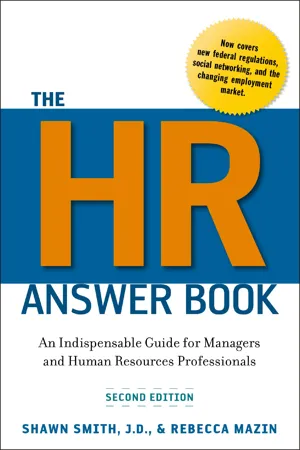Business
Performance Evaluation
Performance evaluation is the process of assessing an employee's job performance and productivity. It involves setting clear expectations, providing feedback, and measuring progress towards goals. This helps in identifying strengths and areas for improvement, and can inform decisions related to promotions, bonuses, and training opportunities.
Written by Perlego with AI-assistance
Related key terms
Related key terms
1 of 4
Related key terms
1 of 3
11 Key excerpts on "Performance Evaluation"
- eBook - ePub
- Elearn(Author)
- 2009(Publication Date)
- Routledge(Publisher)
Evaluating performance
Organisations are continually asking people to perform better. This theme examines ways to set and agree individual goals and provide objective feedback on performance. It also explores how to review team performance in a way that leads to performance improvements.Is development working? There is more pressure today than ever before to produce results from staff development programmes and initiatives. If development is not shown to add value, it may be difficult to justify the expense. This theme looks at how monitoring, measurement and evaluation of development can be used as a management tool to determine what is and is not working as well as anticipated.In this theme you will:Explore the processes used to review individual and team performancePlan to meet the performance review needs of individualsIdentify ways of evaluating developmentConsider ways of increasing the effectiveness of development.Performance reviews
A performance review or appraisal is where you provide feedback to your team and individual members of the team on their performance and set goals for the future. You should regard this as one of your most important responsibilities. The purpose of a performance review is to:improve the individual's – and therefore, an organization's performance. To do so, the appraisal has to be responsive to individual needs and be available to individuals throughout the organization. - eBook - ePub
- Raymond J. Stone, Anne Cox, Mihajla Gavin(Authors)
- 2020(Publication Date)
- Wiley(Publisher)
Performance appraisal is a key part of an organisation’s performance management system. The focus of performance appraisal is on each individual employee. Performance appraisal typically involves measuring how well an individual employee is doing their job against a set of criteria (e.g. personal competencies, behavioural characteristics or achievements), providing feedback and creating a development plan.The performance appraisal process generates information that may be used for administrative purposes (such as rewards, promotions, transfers and terminations) and/or developmental purposes (such as training and development, coaching and career planning) and/or research purposes (such as validating selection procedures and evaluating the effectiveness of training). It signals to managers and employees what is really important (e.g. diversity can be encouraged if it is incorporated into the performance appraisal); it provides ways to measure what is important; it fixes accountability for behaviour and results; and it helps to improve performance.11 Research also shows that appraisals that recognise the quality of an employee’s work are positively related to lower turnover intentions and that development-oriented appraisals are significantly linked to organisational commitment.12 Other research indicates that where employees perceive the performance appraisal system as consistent and predictable and their treatment by their manager as fair and sensitive, there are positive effects on motivation, job satisfaction, turnover intentions, trust in management, organisational citizenship behaviour, individual job performance, knowledge sharing and innovative behaviour.13 Farndale and Kelliher, similarly, found that where employees perceive fair treatment by their line manager in the performance appraisal process, organisational commitment is higher.14 Finally, there is some evidence to suggest that employee behaviour (ethical or unethical) may be influenced by whether they perceive their appraisals as fair.15 - Michael L. Vasu, Debra W. Stewart, G. David Garson, Michael L. Vasu, Debra W. Stewart, G. David Garson(Authors)
- 2017(Publication Date)
- Routledge(Publisher)
12 Performance Appraisal In a summary of literature on organizational design and systems analysis published in 1965, Haberstroh drew two broad conclusions from his review of performance measurement research: “First, performance reporting is omnipresent and necessarily so. Second, almost eveiy individual instance of performance reporting has something wrong with it” (Haberstroh, 1965). Performance appraisal remains both omnipresent and problematic today (Daley 1992; Zalesny and Highhouse, 1992; Gross, 1995). Performance appraisal is a pivotal management technique with a number of purposes and dimensions. It involves a systematic evaluation of the employee by his or her supervisor or some other qualified person(s) who is familiar with the employee’s performance on the job. The purposes for which performance appraisal can be employed are twofold: judgmental and developmental (Daley, 1992). Performance appraisal in its judgmental expression directly impacts a number of workforce decisions such as promotion, demotion, pay, transfer, and retention. From a judgmental perspective, performance appraisal is explicitly linked to extrinsic rewards and punishments and is an expression of the command and control model of authority (Daley, 1992, p. 16). From a developmental perspective, performance appraisal seeks to “add value” to the employee by developing intrinsic motivation and providing opportunities for training and professional growth (Daley, 1992). Performance appraisal is fundamentally a form of measurement and, therefore, involves questions of validity (are we measuring what we think we are?) and reliability (is that measurement stable over time?). Performance appraisal takes many forms. It may be conducted by means of a standardized instrument that is adapted to the needs of a particular organization. It may involve peer assessment- eBook - ePub
- Tony Alessandra(Author)
- 1986(Publication Date)
- Free Press(Publisher)
Performance appraisal is the process of periodically measuring employees’ progress toward agreed-upon objectives, providing constructive feedback, reinforcing successes with rewards, and taking corrective action if goals are not achieved. Appraisals are important to managers to help develop and obtain the best performance from their employees. According to a 1993 quote in BusinessWeek, former General Electric CEO Jack Welch said, “If we get the right people in the right job, and keep them there, we’ve won the game.” Appraisals are important to employees because they often serve as the basis for promotions, terminations, training opportunities, and pay adjustments. When conducted effectively, performance appraisals can increase productivity and morale and decrease absenteeism and turnover. But when handled poorly, they can have the opposite effects. Performance appraisal is one of the primary tools for helping managers meet organization goals and compete effectively internationally. This chapter is designed to help you develop the skills to ensure that objectives are obtained and that employees learn how to enhance their performance through the performance appraisal process. This includes applying a number of control processes to aid the attainment of objectives, and providing effective feedback to enhance employee performance and development. As you learned in the previous chapter, setting goals is a prerequisite to performance appraisal. The goal-setting process provides a documented statement of what you intend for the subordinate to accomplish, a form of acknowledgment, and a reminder of commitment. Setting objectives also establishes a basis for measuring performance and provides positive motivation to achieve goals - eBook - ePub
- Christopher Mabey, Rosemary Thomson(Authors)
- 2012(Publication Date)
- Routledge(Publisher)
9 Assessing and appraising performanceIntroduction
Earlier chapters in this book have been devoted to getting the right person with the right skills into the right job. Others have considered influences on the individual’s motivation to work and the ways in which managers can develop their staff and help them in their career planning. Central to the effective management of all these processes is the development and management of performance through performance appraisal.Most managers are familiar with the concept of performance appraisal, and there is evidence that an increasing number of large and medium-sized organizations operate formal appraisal systems. Many of these systems have been criticized for their emphasis on reviewing past performance, whereas we would argue that they are equally, if not more, essential in providing the opportunity for the development of individuals and their future performance. They are also frequently linked to remuneration and promotion possibilities, and this multiple purpose can create conflicts in their operation.Despite these issues and others we will explore in this chapter, an effective and fair appraisal system can be the linchpin of human resource developmentPerformance management systems
Performance management systems (PMS), having been widely used in America, were introduced into the UK in the late 1980s. An evaluation of the operations of these systems has been carried out through surveys of public and private sector organizations in the UK, undertaken in 1991 by the Institute of Manpower Studies on behalf of the Institute of Personnel Management. The survey found ‘no evidence to suggest that improved organizational performance in the private sector is associated with the operation of a formal performance management system’. This was a damning indictment of what had been hailed as the answer to the human resource specialist’s prayer. - eBook - ePub
The Story of Industrial Engineering
The Rise from Shop-Floor Management to Modern Digital Engineering
- Adedeji B. Badiru(Author)
- 2018(Publication Date)
- CRC Press(Publisher)
Nearly all strategic management or strategic planning efforts begin with understanding the organization and its environment. This effort is referred to as internal and external strategic analysis (Thompson and Strickland, 2003), organizational systems analysis (Sink and Tuttle, 1989), or, in plain words, “preparing to plan.” A key part of internal analysis is understanding current performance levels, including the current value of key performance indicators and their recent trends. This provides the baseline for future Performance Evaluations of the effectiveness of the planned strategy and its deployment. Also, the choice of key performance indicators tells the organization what is important and is a specific form of direction often more carefully followed than narrative statements of goals and vision. Understanding current performance and its relation to current processes and resources provides managers with a realistic view of what is possible without having to make substantial changes to the system. Thus, setting intelligent targets for future performance requires an understanding of how implementation of the plan will change processes and resources to enable achievement of these targets. A key part of the external analysis is obtaining relevant comparisons so that the competitiveness of current performance levels and future performance targets can be evaluated. To answer the question of how good a particular performance level is, one must ask “compared to what?” Current competitor performance provides an answer to this question, but it must be assumed that competitors are also planning for improved performance. Setting future performance targets must take this moving competitive benchmark into account. Even the projected performance of your best current competitor may be inadequate as a future performance target to beat. The strategic management literature is full of examples of corporations that did not see their new competition coming and were blindsided by new competitors playing by different rules with substitutes for the bread-and-butter products of these corporations (see Hamel, 2002; Hamel and Prahalad, 1996). As Drucker (1998) has pointed out, some of the most important information managers need comes from outside their organizations and even outside their industries. A challenge for performance measurement is to provide not only internal but also external performance information that provides competitive intelligence for making strategic decisions.Most strategic management or strategic planning processes include a last or next to last step that serves to measure, evaluate, and take corrective action. Often, this step is expected to be occurring throughout the process, with the formal execution of the explicit step occurring after goals have been set, action plans have been deployed, and strategy implementation is underway. That is, periodic review of progress toward meeting goals is a regular part of a strategic management effort, and performance indicators can provide evidence of that progress. When the goal-setting process includes the identification of key performance indicators and future performance targets for each indicator, the decision of which indicators to review has largely been made. In cases where goals are perhaps more qualitative or include simple quantitative targets without an operationally defined performance indicator, the planning team must choose or develop a set of progress indicators for these periodic (e.g., monthly or quarterly) reviews. A rule of thumb for these cases, based on the work of Sink and Tuttle (1989), is to develop indicators that provide evidence of the effectiveness, efficiency, quality, and impact of progress on each goal. Each of these terms is defined earlier. Even when key performance indicators have been predetermined at the time of goal setting, additional “drill-down” indicators may be required to explain performance trends and illustrate perceived cause-and-effect relationships among managerial actions, environmental and competitor actions, and observed levels of performance on end-result indicators. - eBook - ePub
- Shawn Smith, Rebecca Mazin(Authors)
- 2011(Publication Date)
- AMACOM(Publisher)
3 Performance Management How Do I Evaluate Performance and Conduct Meaningful Performance Reviews?ASK EMPLOYEES ABOUTperformance management and their experiences giving or receiving performance appraisals and you are likely to hear griping or humorous or scary anecdotes. Companies’ approaches to performance management vary widely. There are organizations with elaborate performance-management systems that combine frequent feedback with documentation, those that use simple forms for one annual discussion copied from other businesses or forms books, and others that use no system at all.Meaningful ongoing performance management helps both individual employees and the business as a whole. Effective performance management is a key for the motivation, retention, and development of employees, because individuals learn how they are performing and where they are going in the organization. Managers learn more about their subordinates in the process, strengthen relationships through discussion, and develop their own coaching skills. The entire organization benefits from a system that aligns performance to company-wide goals, provides a structured format for measuring results and giving feedback, and establishes a record for each employee that can be used for individual development, to inform future supervisors, and to make sound employment decisions.No matter what the size and culture of your organization, it pays to be attentive to performance management. Since there is no single correct approach for every business, you must take steps and adopt structures that fit with and work for your organization. Never just copy the approach of another company and assume that it will work for you. In this chapter, we will discuss some of the considerations involved in developing and implementing a performance-management system that will get you the results you want. - eBook - ePub
Work, Organizational, and Business Psychology
An Introductory Textbook
- Hannes Zacher, Nale Lehmann-Willenbrock, Hannes Zacher, Nale Lehmann-Willenbrock(Authors)
- 2022(Publication Date)
- Kohlhammer Verlag(Publisher)
The basic idea guiding structured performance appraisals, as in Mary’s case, is that companies are only as good as their employees. Especially in knowledge-intensive industries, employees are seen as a company’s most important resource (e.g., Kim & Ployhart, 2014). Consequently, it is crucial for organizations to identify and manage employee performance. Performance feedback, i.e., information about one’s own performance at work, further plays a decisive role for employees themselves (Steelman & Williams, 2019). Employees generally report that they value performance feedback and would like more of it (London, 2003). Meta-analytical findings have shown that this is particularly true for younger employees such as Mary (Anseel et al., 2015). But what exactly is employee performance? In opening this chapter on evaluating and managing employee performance, let’s start with some basic definitions.Broadly speaking, employee performance refers to those actions that contribute to the organization’s goals (for a comprehensive review, see Campbell & Wiernik, 2015). For these actions, the level of proficiency with which the individual performs them must be scaled (specific examples will be provided later in the chapter). It is important not to confuse the behavioral aspects of performance with the outcomes of performance, such as sales or salary, as these are also influenced by factors outside the employee’s immediate control, such as market changes or unforeseen events (Campbell & Wiernik, 2015). Similarly, employee performance needs to be distinguished from the determinants of individual differences in performance. These include both person-specific (e.g., cognitive abilities, personality, and knowledge) and situation-specific variables (e.g., job design, leadership, and reward structure).Digging a little deeper, recent definitions further agree that performance is a multi-dimensional and dynamic construct. With regard to the multidimensional character of employee performance, a frequent distinction found in relevant literature is that between task performance and contextual performance - Barbara A. Miller(Author)
- 2016(Publication Date)
- Jossey-Bass(Publisher)
One of the greatest challenges for assessors engaged in measuring performance at the organization, program, and process levels is to understand the nature and complexity of organizational performance. Organizational performance is defined and measured in multiple dimensions, each of which is linked to specific system elements. This is why assessment of organizational performance always begins with an analysis of the system’s external and internal elements as described in Chapters Two and Three. Wise assessors generally do not measure all dimensions of organizational performance all the time. They are selective, choosing the right performance areas based on specific needs and expectations of different assessment user groups, critical success factors, strategic goals, past performance issues, emerging political and social issues, and other relevant considerations. Areas of Organizational Performance Organizational performance can be defined operationally in many ways. In 1989, Scott Sink and Thomas Tuttle operationally defined seven areas of organizational performance. I formed them into a new combination more suited for assessment in higher education. By now you will recognize these seven areas of organizational performance as the following: 1. Effectiveness: a measure of the extent to which the unit achieves its intended outcomes 2. Productivity: a ratio of outputs created to inputs consumed 3. Quality: a complex area of performance measured in six dimensions: Quality of upstream systems (Q 1) Quality of inputs (Q 2) Quality of key work processes (Q 3) Quality of outputs (Q 4) Quality of leadership systems (Q 5) Quality of worklife (Q 6) 4. Customer and stakeholder satisfaction: a measure of the level of satisfaction of internal and external customers and stakeholders 5. Efficiency: a measure of resource utilization and the costs and benefits of quality management 6. Innovation: a measure of creative changes put into place to improve organizational performance 7- Chris Wolsey, Sue Minten, Jeffrey Abrams(Authors)
- 2011(Publication Date)
- Routledge(Publisher)
This chapter has sought to provide a framework for the development and integration of a Performance Evaluation system within sport and leisure organisations. Performance Evaluation and rewards should take place within a strategic approach to HRM. This needs to take account of the open systems context in which most organisations operate. External factors influence the internal dynamics of the organisation and managers must ensure that performance and reward systems are flexible enough to respond to such challenges. The chapter has reviewed many factors that contribute to a wider and deeper understanding of the Performance Evaluation within sport and leisure organisations. Performance Evaluation should not be considered an end in itself, but merely a means to an end. It should not be concerned with inputs or outputs in isolation, but must take a more eclectic look at what, why and how related products and services are provided. It requires a range of value judgements to be made with respect both to interpersonal relationships and to resource allocation. Targets should not simply be imposed without prior discussion, but should be consultative in nature. Performance appraisal allows interested parties to monitor direction and establish trade- offs between competing and often contradictory demands for limited resources.What is clear is that there is no one best way of organising this and that there are a number of different stakeholders to account for within this process. As a consequence, each organisation, each team and each individual represents a unique set of motivations and associated implications, both positive and negative. It is only when all such factors are combined do the inputs both of capital and of human resources transform into outputs that can be measured against the raison d’être- James L. Moseley, Joan C. Dessinger, James L. Moseley, Joan C. Dessinger(Authors)
- 2009(Publication Date)
- Pfeiffer(Publisher)
how we approach it.Passage contains an image
In his elegant little book devoted, not to measurement and evaluation, but to the essence of sustainable performance improvement, Esque (2001, p. 18] states that: “In its simplest form, managing work consists of three components:CHAPTER ONE Measurement, Evaluation, and Research:
Carl BinderFeedback for Decision Making- Setting goals;
- Letting work happen and comparing work completed against goals; and
- Deciding whether to change how the goals are being pursued.”
In other words, there are three conditions that must be in place to say that performance is being managed: (1) clear, measurable goals; (2) measurement feedback provided to the performers in order to make decisions; and (3) the ability to control resources and conditions if the measurement feedback indicates need for a change.In the field of human performance technology (HPT), this understanding of performance management provides a rationale for measurement and evaluation. We clearly identify the changes in performance we seek to produce. We measure and monitor the performance over time to determine whether our goals are being achieved, and at what rate. And we decide, based on the feedback provided by measurement, whether (and sometimes how) to change conditions when our goals are nor being met.This logic applies at two levels in our field. First, when we as performance improvement professionals are called in to help address a performance challenge, we must ensure that the three conditions described by Esque (2001) are in place. In fact, unlike many of our colleagues in the performance improvement field who conduct cause analyses at the front end of projects to determine what interventions to propose, Esque follows a simpler path: He asks whether the three conditions are in place. Then, because they usually are not
Index pages curate the most relevant extracts from our library of academic textbooks. They’ve been created using an in-house natural language model (NLM), each adding context and meaning to key research topics.
Explore more topic indexes
Explore more topic indexes
1 of 6
Explore more topic indexes
1 of 4










